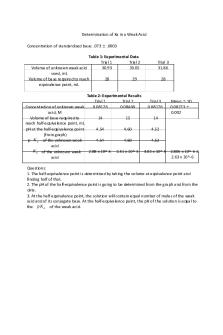Spectrophotometric Determination of the p Ka of Bromothymol Blue PDF

| Title | Spectrophotometric Determination of the p Ka of Bromothymol Blue |
|---|---|
| Author | Angie Pratte |
| Course | Analytical Chemistry |
| Institution | New York City College of Technology |
| Pages | 7 |
| File Size | 189 KB |
| File Type | |
| Total Downloads | 90 |
| Total Views | 134 |
Summary
Spectrophotometric Determination of the p Ka of Bromothymol Blue lab report
Introduction, Materials, Methods, Data, Results, Discussion, Conclusion....
Description
Experiment: Spectrophotometric Determination of the pKa of Bromothymol Blue Russybel Richiez S. Tewani Date Submitted: May 4, 2020
Title: Spectrophotometric Determination of the pKa of Bromothymol Blue Introduction: The purpose of this lab was to find the value of pKa of Bromothymol Blue Indicator. Bromothymol Blue Indicator is a ph indicator which The equation below allows for the pKa to be found given the pH, In- which is the Products and the HIn which is the reactants Pka=pH-log ([In ]/[HIn])
By monitoring the pH of a solution one can find the Ka of the indicator in use. For this experiment the acidic and basic forms of the indicator absorb more strongly at different wavelengths. The first wavelength λ1, is where the acidic form of the indicator absorbs the radiation strongly. The second wavelength λ2, is where the basic absorbs the radiation strongly. From Beers law we know that for pH changes, concentrations of each form will change according to the Ka of the indicator meaning the absorbance for each form will also change. In solutions of low pH, essentially all of the indicator is in the acid form. In highly basic solutions essentially all of the indicator is in the basic form
It was found that
Materials:
Cuvette 1-mL pipet 5-mL pipet pH meter and electrodes 0.10M KH2PO4 solution 0.10M Na2HPO4 solution Concentrated Hydrochloric 10-mL graduated cylinder 2, 25-mL volumetric flasks Scanning spectrophotometer 4.0M Sodium hydroxide solution Bromothymol blue solution (0.1% in 20% ethanol)
Procedure: 1. A pipet to was used to deliver 1.00 ml of the Bromothymol blue solution to each of the two, labeled, 25ml volumetric flasks. 5 ml of distilled or deionized water and 4 drops of concentrated hydrochloric acid were added to one of the flasks. The solution was diluted to the mark with water. The resulting solution should have a pH of about 1. To the second flask 12 drops of 4.0M Sodium hydroxide solution were added and filled the flask to the mark with water. The solution should have a pH of about 13. 2. The 10, 25-ml volumetric flasks were labeled with numbers 1 through 10. A pipet was used to deliver 1.00 ml of the Bromothymol blue solution to each of the flasks. The volumes of the 0.10 M Na2HPO4 solution and the 0.10 M KH2PO4 solution were added to each flask that are indicated in the table. Each solution was diluted to the mark with water.
Flask Number
mLs of KH2PO4
mLs of Na2HPO4
1 5 0 2 10 0.5 3 5 1 4 10 5 5 5 5 6 5 10 7 1 5 8 1 10 9 0.5 10 10 0 5 3. The pH meter was used to measure the pH of the pH 1, hydrochloric acid solution, the pH 13, sodium hydroxide solution, and the 10 solutions. The pH of each solution was recorded. 4. Using the scanning spectrophotometer, the spectra between 300 and 800 nm of the pH 1 and the pH 13 bromothymol blue solutions were obtained and recorded. From the recorded spectra one wavelength ( λ1) was chosen at which the pH 1 solution absorbs strongly but the pH 13 solution absorbs weakly, and a second wavelength ( λ2) at which the pH 13 solution absorbs strongly but the pH 1 solution absorbs weakly. 5. The absorbance of each of the 12 solutions at the two chosen wavelengths were measured and tabulated.
Data: Figure A1: Dependence of absorbance HIn and In- on pH
pH Vs ABSORBANCE 0.35 0.3
aBSORBANCE
0.25 0.2 0.15 0.1 0.05 0
0
2
4
6
8
PH
10
Abs at 435 nm
12 Abs at 620 nm
Figure A2: pH vs. log([In-]/[HIn])
PH VS Log(In/Hin) 1.5 1
Log(In/Hin)
0.5 0
0
2
4
6
8
-0.5 -1 -1.5 -2 -2.5 ph
Results
10
12
14
Log(In/Hln)
14
Discussion:
Conclusion:
References:
Appendix:...
Similar Free PDFs

P Ka - pka
- 1 Pages

Tablas p Ka
- 6 Pages

KA P S - The Lazy OCD Version
- 85 Pages

Determination of Ksp CuIO3
- 5 Pages

Experimental Determination of π
- 3 Pages
Popular Institutions
- Tinajero National High School - Annex
- Politeknik Caltex Riau
- Yokohama City University
- SGT University
- University of Al-Qadisiyah
- Divine Word College of Vigan
- Techniek College Rotterdam
- Universidade de Santiago
- Universiti Teknologi MARA Cawangan Johor Kampus Pasir Gudang
- Poltekkes Kemenkes Yogyakarta
- Baguio City National High School
- Colegio san marcos
- preparatoria uno
- Centro de Bachillerato Tecnológico Industrial y de Servicios No. 107
- Dalian Maritime University
- Quang Trung Secondary School
- Colegio Tecnológico en Informática
- Corporación Regional de Educación Superior
- Grupo CEDVA
- Dar Al Uloom University
- Centro de Estudios Preuniversitarios de la Universidad Nacional de Ingeniería
- 上智大学
- Aakash International School, Nuna Majara
- San Felipe Neri Catholic School
- Kang Chiao International School - New Taipei City
- Misamis Occidental National High School
- Institución Educativa Escuela Normal Juan Ladrilleros
- Kolehiyo ng Pantukan
- Batanes State College
- Instituto Continental
- Sekolah Menengah Kejuruan Kesehatan Kaltara (Tarakan)
- Colegio de La Inmaculada Concepcion - Cebu










